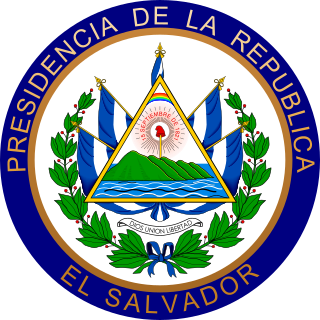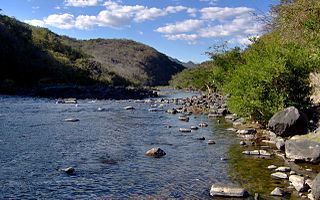
El Salvador, officially the Republic of El Salvador, is a country in Central America. It is bordered on the northeast by Honduras, on the northwest by Guatemala, and on the south by the Pacific Ocean. El Salvador's capital and largest city is San Salvador. The country's population in 2021 is estimated to be 6.8 million.

Santa Ana is the second largest city in El Salvador, after the capital of San Salvador. It is located 64 kilometers northwest of San Salvador, the capital city. Santa Ana has approximately 374,830 (2017)) inhabitants and serves both as the capital of the department of Santa Ana and as the municipal seat for the surrounding municipality of the same name. For its administration the municipality is divided into 35 colonias (neighborhoods) and 318 small villages.

The president of El Salvador, officially known as the President of the Republic of El Salvador, is the head of state and head of government of El Salvador. He is also, by Constitutional Law, the commander-in-chief of the Armed Forces of El Salvador. The office was created in the Constitution of 1841. From 1821 until 1841, the head of state of El Salvador was styled simply as Head of State.

Cabañas is a department of El Salvador in the north central part of the country. Its capital is Sensuntepeque and it is one of coolest parts of El Salvador. Classified as a department in February 1873, it covers an area of 1,103.5 km2 (426.1 sq mi) and has over 164,900 inhabitants. The other major city of the department is Ilobasco. Agricultural produce includes coffee, sugar cane and sesame seeds, as well as dairy products. Gold, silver and copper are the principal minerals mined in the department. Its main industrial activity is oriented to manufacture of potteries, cheese, lime and also distilleries.

San Vicente is a department of El Salvador in the center of the country. The capital is San Vicente. On October 4, 1834, San Vicente City of Austria and Lorenzana was made the capital of State of El Salvador during the Federal Republic of Central America. In 1840, it was no longer the capital of the State of El Salvador, but it continues to be the capital of the department. The department was created on June 12, 1824. The San Vicente department is 1,184 km2 (457 sq mi) and has a population in excess of 174,500. The forest Bosque La Joya is found in San Vincente.

Colonel José María San Martín was a military officer, politician and President of El Salvador.

Santiago Nonualco is a municipality in La Paz department of El Salvador.

Cojutepeque is the capital city of El Salvador's Cuscatlán department. It also served as the capital of San Salvador during several years. It also serves as the administrative centre for the surrounding municipality of Cojutepeque. Its population is estimated at 70,000 people with about 85% living in the urban areas of the municipality.
Independiente Futbol Club is an Salvadoran professional football club based in San Vicente, San Vicente, El Salvador. They currently play in the Primera División El Salvador, the top tier of El Salvador football. The club was formed in 1946 and has played at its home ground, Estadio Jiboa, since TBD.

Lake Ilopango is a crater lake which fills an 8 by 11 km volcanic caldera in central El Salvador, on the borders of the San Salvador, La Paz, and Cuscatlán departments. The caldera, which contains the second largest lake in the country and is immediately east of the capital city, San Salvador, has a scalloped 100 m (330 ft) to 500 m (1,600 ft) high rim. Any surplus drains via the Jiboa River to the Pacific Ocean. An eruption of the Ilopango volcano is considered a possible source for the extreme weather events of 535–536. The local military airbase, Ilopango International Airport, has annual airshows where international pilots from all over the world fly over San Salvador City and Ilopango lake.

El Salvador International Airport Saint Óscar Arnulfo Romero y Galdámez, , previously known as Comalapa International Airport and also known as the Comapala Air Base by the military, is an joint-use civilian and military airport that serves San Salvador, El Salvador. It is located in the south central area of the country, in the city of San Luis Talpa, Department of La Paz, and occupies a triangular plain of 2519.8 acres, which borders the Pacific Ocean to the south, to the east with the Jiboa River, and to the northwest with the coastal highway. Being close to sea level, it allows aircraft to operate efficiently at maximum capacity. It is connected to the capital of San Salvador, El Salvador through a modern four-lane motorway, with 42 kilometers travel in an average time of 30 minutes.
Club Deportivo Platense Municipal Zacatecoluca, usually abbreviated to just Platense, is a Salvadoran football club s based in Zacatecoluca, the departmental capital city of La Paz Province, they currently play in the Primera División. The club play their home games at the Estadio Panorámico de Zacatecoluca, which has a capacity of 10,000

The Lempa River is a 422-kilometre (262 mi) long river in Central America.

The Torola River is a river in El Salvador and Honduras.
Water resources management in El Salvador is characterized by difficulties in addressing severe water pollution throughout much of the country's surface waters due to untreated discharges of agricultural, domestic and industrial run off. The river that drains the capital city of San Salvador is considered to be polluted beyond the capability of most treatment procedures.
Club Deportivo El Vencedor, commonly referred to as El Vencedor, is a Salvadoran professional football club based at Santa Elena, Usulután Department, El Salvador. It plays in Primera División, having gained promotion from Segunda División Salvadorean in 2018–19.
Group Megavisión is a Salvadoran broadcasting company that operates three television channels and more than twenty national radio stations. It was founded by Óscar Antonio Safie.
The 2017–18 Primera División de Fútbol Profesional season is the 19th season and 37th and 38th tournament of El Salvador's Primera División since its establishment of an Apertura and Clausura format. Santa Tecla F.C. the defending champions of the Apertura and Clausuray. The league will consist of 12 teams. There will be two seasons conducted under identical rules, with each team playing a home and away game against the other clubs for a total of 22 games per tournament. At the end of each half-season tournament, the top eight teams in that tournament's regular season standings will take part in the playoffs.












